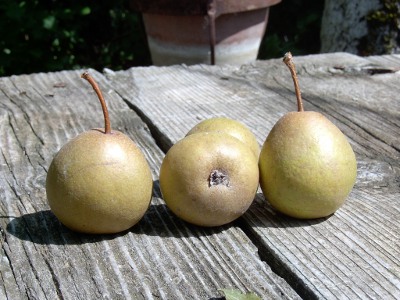︎︎︎ PERA BRUTTA E BUONA

Le piante madri sono state ritrovate in diverse zone della Alta Valle del Tevere, sia nella parte toscana che umbra. L’origine è probabilmente toscana. Può essere adatta alla coltivazione nelle zone di alta collina. L’albero è mediamente vigoroso, rustico e a portamento quasi assurgente, è molto produttivo e fiorisce in epoca medio tardiva. Questa pera è di grandezza medio piccola, sferoidale, con il peduncolo medio e non grosso. I frutti sono spesso riuniti in grappoli. La cavità calicina è poco pronunciata. La buccia è spessa, di colore verde, ma comunque completamente ricoperta di ruggine. La polpa è bianca, succosa, croccante, di ottimo sapore e poco granulosa. I frutti vengono raccolti alla fine di agosto e sono adatti al consumo fresco. È probabilmente quella che il Gallesio nella sua Pomona Italica descrive come la Brutta e Buona di Giaveno, ed era diffusa in Toscana, Umbria e Romagna.
È molto simile anche alla Bugiarda o Inganna villani. Per la sua dolcezza e consistenza della polpa è adatta a molti usi in cucina.
The mother plants were recovered in various areas of the High Tiber Valley, both in the Tuscan and in the Umbrian side. Its origin may be Tuscan. It would be suited for cultivation in high hills areas. The tree is on the moderately vigorous, rugged and with almost compressed habit. It is very productive and blooms in mid-to late season. The fruit is of medium-small size, spherical in shape and with a medium and not too thick stem. These pears often fruit in cluster. The calyx is not too marked. The skin is thick, green but completely covered with russeting. The flesh is white, juicy and crisp; it has excellent flavor and is not too granular. The fruits are harvested at the end of August and are suitable for fresh eating. They travel well. Chances are that this pear is the same one that Gallesio describes in his Pomona Italica as the Brutta e Buona di Giaveno. It was widespread in Tuscany, Umbria and Romagna. It is very similar to the Bugiarda or Inganna Villani. Because of the sweetness and firmness of its flesh, this fruit is suitable for many uses in cooking.